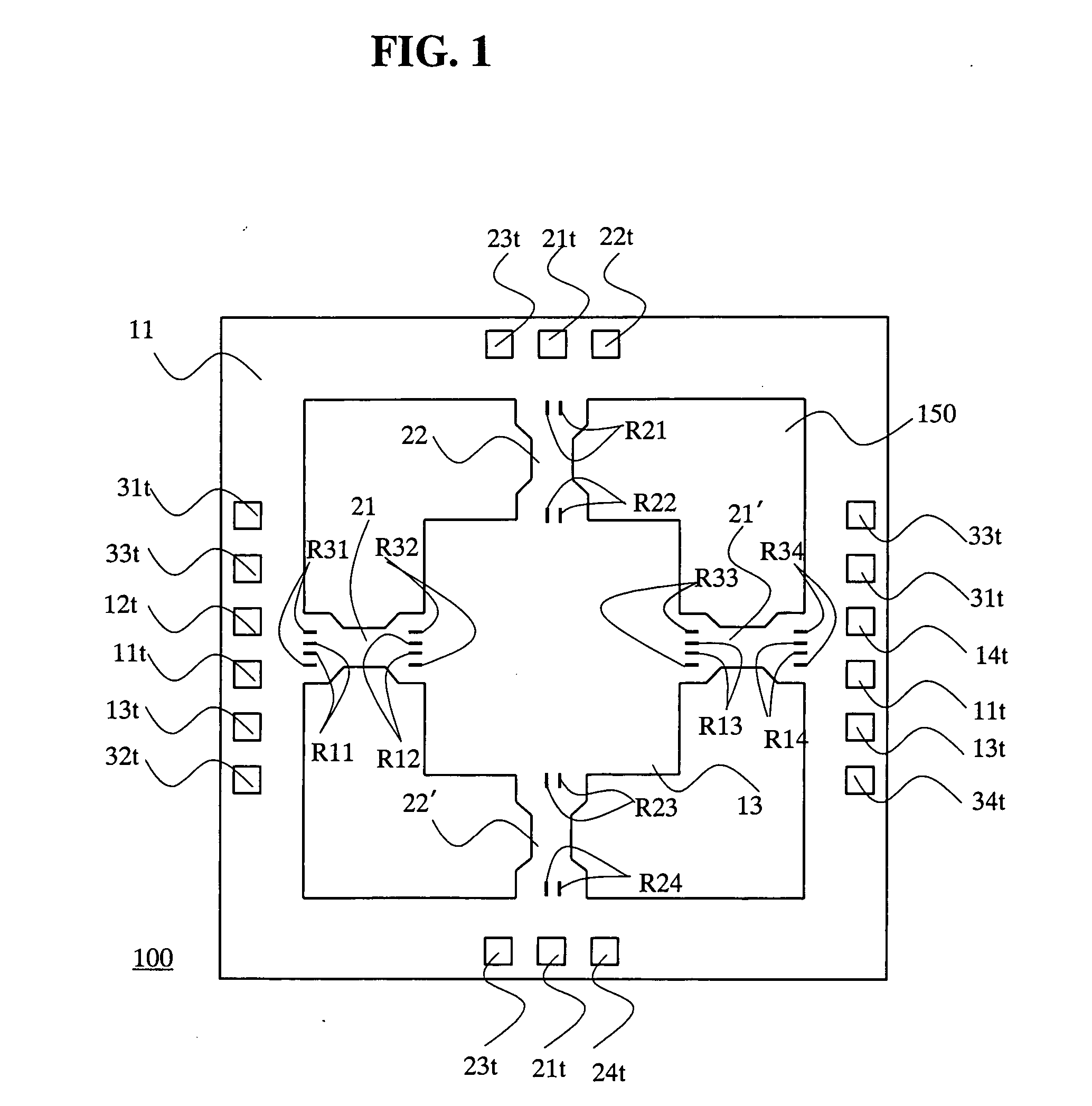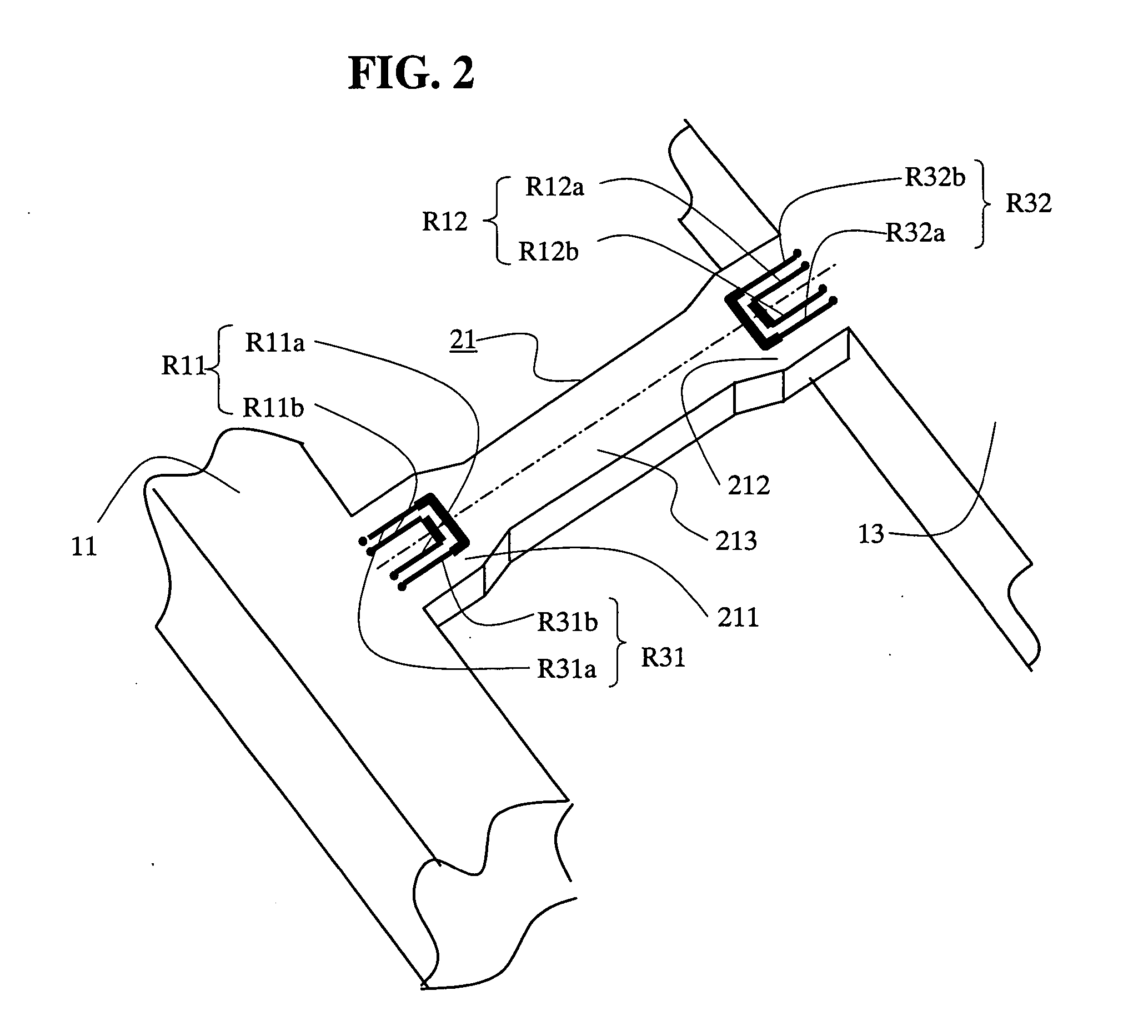Semiconductor acceleration sensor
a technology of acceleration sensor and semiconductor, applied in the direction of speed/acceleration/shock measurement, force measurement, instruments, etc., can solve the problems of high manufacturing cost, high cost, irregular delivery time, etc., and achieve the effect of reducing offset voltage, excellent sensitivity, and low temperature dependence of offset voltag
- Summary
- Abstract
- Description
- Claims
- Application Information
AI Technical Summary
Benefits of technology
Problems solved by technology
Method used
Image
Examples
example 1
[0046] Referring to FIGS. 1 through 5, a semiconductor acceleration sensor of the invention will be described below. FIG. 1 is a plan view showing the semiconductor acceleration sensor. FIG. 2 is a perspective view showing the enlargement of a flexible arm of the semiconductor acceleration sensor. In FIGS. 1 and 2, metal wires are omitted.
[0047] The semiconductor acceleration sensor of the invention is made up of a silicon single crystal substrate where an SOI layer is formed through an SiO2 insulating layer to accurately control the thickness of the flexible arm, that is, an SOI wafer. SOI is an abbreviation of Silicon On Insulator. In this example, a thin SiO2 insulating layer (about 1 μm) serving as an etching stopper is formed on an Si wafer having a thickness of about 625 μm. A wafer having an N-type silicon single crystal layer with a thickness of about 10 μm is used as a substrate on the insulating layer. In a semiconductor acceleration sensor 100 of this example, four L-sha...
example 2
[0072] According to the semiconductor acceleration sensor of Example 1, acceleration sensors were manufactured in which the narrower portions of flexible arms (700 μm in length) are changed in length from 200 μm to 400 μm, and sensitivity ratios (Ex / Ez) were evaluated. The flexible arms had an even thickness of 5 μm, and the dimensions of a piezo resistor, the dimensions of a metal wire, and the thickness of a silicon oxide insulating layer were the same as the acceleration sensor of Example 1. A wider portion was 110 μm in width, the narrower portion was 52.5 μm in width, and a cross section area ratio (b / a) of a cross section area (b) of the wider portion to a cross section area (a) of the narrower portion was 2.1.
[0073] Twenty acceleration sensors were prepared in which narrower portions were changed in length from 200 μm to 400 μm. The acceleration sensors were placed in the protection case shown in FIG. 15. The bottom of a support frame was fixed on a bottom plate in the prote...
example 3
[0074] A semiconductor acceleration sensor of Example 3 has a flexible arm different in shape from Example 1. As shown in the perspective view of FIG. 8, in the flexible arm of the semiconductor acceleration sensor according to Example 3, wider portions 211′ and 212′ and a narrower portion 213′ have an equal width of 110 μm. The narrower portion 213′ is thinner than the wider portions 211′ and 212′. The wider portion was 8 μm in thickness and the thickness of the narrower portion was changed from 1.74 μm to 8 μm.
[0075] Twenty acceleration sensors were manufactured in which a cross section area ratio (b / a) of a cross section area (b) of the wider portion to a cross section area (a) of the narrower portion was changed from 1 to 4.6, and the sensitivity and the impact resistance were evaluated. The acceleration sensors were placed in a protection case shown in FIG. 15. The bottom of a support frame was fixed on a bottom plate in the protection case with adhesive and a clearance betwee...
PUM
 Login to View More
Login to View More Abstract
Description
Claims
Application Information
 Login to View More
Login to View More - R&D
- Intellectual Property
- Life Sciences
- Materials
- Tech Scout
- Unparalleled Data Quality
- Higher Quality Content
- 60% Fewer Hallucinations
Browse by: Latest US Patents, China's latest patents, Technical Efficacy Thesaurus, Application Domain, Technology Topic, Popular Technical Reports.
© 2025 PatSnap. All rights reserved.Legal|Privacy policy|Modern Slavery Act Transparency Statement|Sitemap|About US| Contact US: help@patsnap.com



